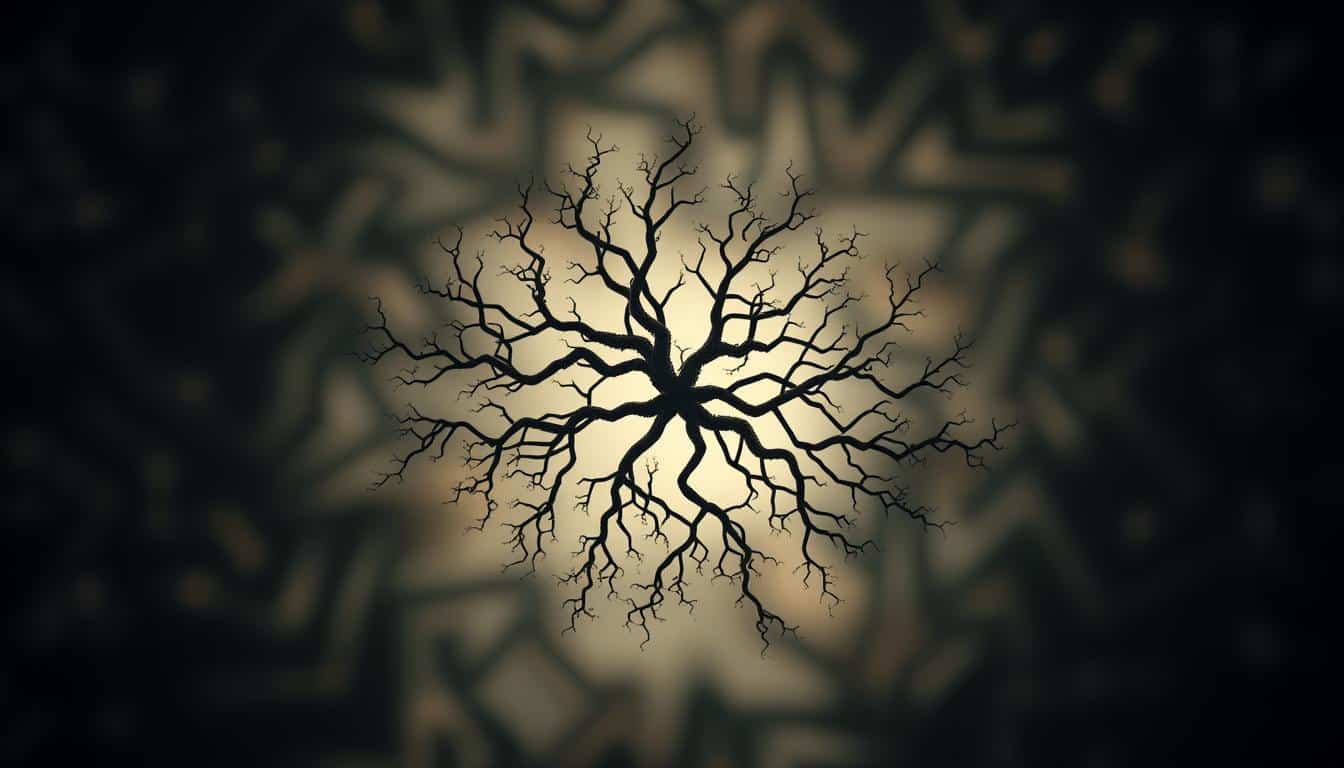Fractal theory has changed how we see math, offering new views on complex designs. It was started by Benoit Mandelbrot’s important discoveries. These ideas mix chaos theory and self-similarity, pushing the limits of traditional math.
This discussion helps us see reality in a new way, linking math to the natural world. Through this journey, we see how fractal theory and different areas come together. This union helps us understand our world better.
The Origins of Fractal Theory
Fractal theory looks at complex geometric patterns that repeat at different sizes. It started with early math ideas from the 17th century. These ideas focused on recursion.
The field really grew in the late 20th century with the help of Benoit Mandelbrot. He helped people see the beauty in nature’s irregular shapes, not just in perfect geometry. This was a big change, focusing on patterns that repeat on many levels.
This shift made us understand math and the natural world better. It linked abstract ideas to the beauty we see in chaos.

Understanding the Concept of Fractals
Fractals are deeply interesting in math because of their complexity and unusual dimensions. They are geometric shapes. These shapes keep their complexity at different sizes. This means fractals show more details when you look closer, unlike normal shapes.
Definition and Characteristics of Fractals
A fractal is known for its repeating patterns. These patterns give it a visual richness you won’t find in simple geometry. They are noted for:
- Complex shapes and structures.
- Ability to show detail at different levels of magnification.
- Mathematical properties that often defy conventional dimensions.
Self-Similarity and Fractal Dimensions
One captivating feature of fractals is self-similarity. This means a fractal looks similar at different sizes. It shows unity in its complexity. The idea of fractal dimensions goes beyond normal measurement. Fractal dimensions can be more than whole numbers.
They describe how complex structures like the Mandelbrot set are. These dimensions help us see complexity in new ways, both in math and in how we think about the world.
Historical Development of Fractal Geometry
The story of fractal geometry is filled with deep mathematical ideas and advances. The early stages go back to Karl Weierstrass and Georg Cantor. Their efforts in function and set theory helped us grasp complex shapes and structures.
Key Contributors to Fractal Theory
The evolution of fractal theory was shaped by several key minds:
- Karl Weierstrass: His work on continuous functions shed light on mathematical concepts.
- Georg Cantor: He delved into infinite sets, offering valuable views on dimensions and math.
- Benoit Mandelbrot: He’s a major name, making fractals known and exploring their traits.
Mandelbrot’s Role in Fractal Geometry
Benoit Mandelbrot was crucial in fractal geometry’s story. In 1975, he introduced the term “fractal.” He talked about shapes that look similar at different sizes. His landmark book in 1982, “The Fractal Geometry of Nature,” was a breakthrough. It linked math theory with real-world patterns, showing how fractals describe nature’s irregular shapes and designs.
Fractal Theory in Mathematical Philosophy
Fractal theory brings a new angle to mathematical philosophy. It changes how we see knowledge and truth. It helps us better understand the complex patterns that look like the chaotic ways of reality.
The use of fractals in philosophy deepens our exploration of big ideas in epistemology.
Key Philosophical Concepts
In mathematical philosophy, fractals shed light on ideas like infinity and self-similarity. These ideas make us question the usual limits of understanding. They make us wonder how these complex forms fit into what we know about math truths.
By looking at abstract shapes, fractals make us think differently about math concepts. They push us to expand the way we think about philosophical ideas.
Impact on Epistemology
Fractal theory changes how we think about knowledge. By challenging what’s normal, it makes us rethink how we see and gain knowledge. This makes the link between seeing and understanding more complex.
It makes us think over how nature’s complex patterns affect how we view the world. This opens new doors for discussions on what knowledge means in our complex world.
Fractal Theory and Its Impact on Mathematical Philosophy
Fractal theory has changed how we see complexity and reality in math. It echoes the thoughts of philosophers like Nietzsche. They question the idea of fixed truths and set patterns. This links well with fractals, which are all about patterns that repeat but aren’t exactly the same.
Influence of Nietzsche’s Perspectives
Nietzsche talked about how we understand knowledge and reality. He didn’t like strict rules in finding truth and logic. This is much like fractal theory, which doesn’t follow straightforward paths. His ideas push us to trust our gut and expect the unexpected. These are key in understanding both Nietzsche’s views and fractals.
Connections to Modern Mathematical Thought
Fractals show that simple math can’t always describe complex systems. They hint that the usual way of thinking about math falls short when dealing with nature’s messiness. By combining philosophy and math, fractals make us see patterns in a new light. They push both philosophers and mathematicians to explore new ideas.
Fractals in Nature and Science
Fractals are found everywhere in nature, showing detailed patterns that unveil the world’s hidden structure. From the edge of the sea to the clouds in the sky and the way trees branch out. These repeating patterns are a basic part of how nature is built. Scientists study fractals to better grasp complex systems, especially in physics and economics.
Examples of Natural Fractals
You can see natural fractals in many places, all sharing similar self-repeating features. Notable examples include:
- Coastlines, where irregular shapes repeat on different scales.
- Cloud formations that exhibit varied complexities and structures.
- Tree branches that display a consistent branching pattern, mirroring the fractal nature of growth.
Fractals in Physics and Economics
In physics, fractals help us understand messy flows and chaotic systems better. They refine models for complex behaviors. Scientists use fractal geometry to study patterns. These patterns show the hidden processes behind how energy moves in wild fluids. In economics, fractals help decipher market trends and price changes, revealing patterns in what seems random.
The Role of Intuition in Fractal Geometry
Intuition is a vital part of understanding fractal geometry. It helps link abstract math concepts to real-world uses. Benoit Mandelbrot showed that recognizing fractal patterns takes trained intuition.
Through training, people can better understand their environment. This results in a deeper knowledge of the world around them.
Fractals show how math is linked to nature. When people learn about fractals, they use their intuition to see patterns everywhere. This encourages creativity in many areas like physics, economics, and art.
- Fractals aid in analyzing natural phenomena, leading to scientific breakthroughs.
- Creative design in architecture often incorporates fractal structures, enhancing aesthetic value.
- Economic models utilize fractals to forecast market behaviors.
Boosting intuition in fractal geometry isn’t just for math. It also sparks new ideas in many fields.
Applications of Fractals in Various Fields
Fractals are amazing in how they show up in art, architecture, and tech. They are not just beautiful; they also solve complex problems. This blend of beauty and usefulness shows how important fractals are today.
Fractals in Art and Architecture
Fractal patterns amaze us in art. Artists like Jackson Pollock and M.C. Escher use fractals to dive deep into complexity. In architecture, the Sagrada Família is a prime example. Its spirals and shapes show fractals’ ability to add beauty and improve structure.
Use of Fractals in Technology
In tech, fractals are key for computer graphics and data. They help make video game landscapes look real and improve rendering. Fractals also make storing and sending digital data easier. This shows their role in linking art with tech progress.
Critiques of Mathematical Formalism
The issue of balancing mathematical rules and gut feeling is big in philosophy talks. Critics say sticking too much to rules can kill creativity and miss the real essence of math. They echo Friedrich Nietzsche’s thoughts, who doubted how stiff rules were in science.
Nietzsche stressed the importance of intuition. He thought leaning too much on rules could block us from truly understanding math.
Nietzsche vs. Mathematical Rigor
Nietzsche went against the usual beliefs about math’s strictness. He pushed for a flexible view of math, similar to fractal theory that likes complexity and unevenness. His critique makes us think about how we come to know and understand things differently.
It sparks debates about how mixing rules and gut feeling is key for deeper insight into math.
Modern Views on Fractals
Recent studies on fractal theory show its big impact on today’s math philosophy. It helps us appreciate how complexity and chaos appear in many areas. Scholars link fractals to important topics in current philosophy.
Fractal Theory’s Impact on Contemporary Math Philosophy
Looking into fractals leads to new ideas in philosophy. It sparks talks about what we know and how we see the world, introducing a non-linear view of math. This changes old ideas and brings new insights into fields like physics and economics.
- Fractals illustrate the intricate patterns found in nature.
- They offer a visual representation of mathematical chaos.
- Fractal theory promotes interdisciplinary dialogue, integrating ideas across diverse realms.
As ideas change, fractal theory shapes our view of complex systems and actions. This interaction makes the field of philosophy even richer. It shows fractals’ importance goes way beyond math.
The Future of Fractal Geometry in Mathematical Philosophy
Fractal geometry is making a big impact on mathematical philosophy. As new research comes out, fractals are getting more attention in many areas. This shows us a future where fractals could change both theories and real-life uses.
Emerging Trends and Research
New studies show fractals can help us get complex systems. They are being used in different fields like biology, tech, and economics. This shows how fractals can link deep ideas to things we see and use every day.
- Enhanced analysis of natural phenomena through fractal modeling.
- Incorporation of fractals in machine learning algorithms for data analysis.
- Investigation of fractal structures in financial markets and behavioral economics.
These trends show we’re starting to see how important fractals are. As we learn more, fractals might change our ideas about math and shine a light on complex mysteries. They could open up new ways of understanding in both math and philosophy.
Conclusion
Fractal theory is changing how we see math and the world around us. It shows us the beauty in complex patterns and how everything connects. This helps experts in both math and science learn more about the universe.
This theory is not just about numbers. It makes us think deeper about how we understand things. It encourages us to look at problems from different angles.
The connection between fractals and deep thinking is key. As fractal theory develops, its role in math and deep discussions will grow. This means we’ll keep finding new ways to use and think about fractals in the future.



